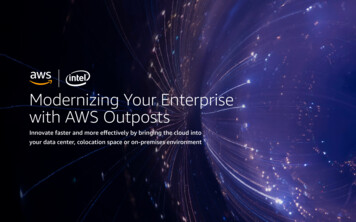
Transcription
Modernizing Your Enterprisewith AWS OutpostsInnovate faster and more effectively by bringing the cloud intoyour data center, colocation space or on-premises environment1
3The Road to Modernization4The Problems of Incompatibility5AWS Outposts Brings the Cloud Where You Need It6Getting Started with AWS Outposts7Philips: AWS Outposts in Action9Protecting Data Inside AWS Outposts11Deciding What to Migrate to Outposts and How to Shift Workloads13Creating a Migration Plan14How AWS Outposts Help Modernize Your Enterprise 2
The Road to ModernizationThe pace of change in virtually every industry is quicker thanCertain workloads can be moved to the cloud relatively easilyit’s ever been. In response to these ever-evolving conditions,– think production workloads like media & entertainmentorganizations are being forced to innovate faster. At theservices, e-commerce applications and Customer Relationshipsame time, the need to reduce costs is ever-present. ByManagement systems. Others are more challenging. Latency,modernizing their technology foundations, businesses candata processing or data residency requirements may demanddrive down overhead while putting in place the enablers ofthat certain data or applications reside locally. Legacyagility, efficiency and growth.software may not (yet) be cloud-ready.Cloud technology helps achieve these needs, simplifying ITIssues such as these explain why even the most forward-with fully managed infrastructure and increased IT efficiencythinking organizations haven’t fully modernized using theand responsiveness to business needs. It also helps to amplifycloud. What’s needed is cloud services capability, delivereddeveloper productivity with common APIs, management,on-premises. AWS brings this to where customers needs ittools, and a broad ecosystem of partner solutions.through AWS Outposts.3
The Problems of IncompatibilityIT administrators and operators remain frustrated by the complexprocurement and provisioning cycles required by on-premiseshardware. Procurement can involve coordinating numerous vendorsOn-premises data centers traditionally use a variety of infrastructure, tools,and take months to get servers installed. Once installed, techniciansand APIs. This disparate assortment of hardware and software solutions resultsconstantly battle with the need to patch and upgrade equipment,in complexity. In turn, this leads to greater management costs, the inability ofand then face incompatibility issues across the various hardware andstaff to translate skills from one setting to another, and limits innovation andsoftware components affected by those upgrades. These teams mustknowledge-sharing between environments.also juggle application downtime during maintenance, so thatupgrades can happen safely and minimize impact on businessDevelopers feel frustration when they have to use different services and APIs,continuity and operations.depending on where they’re working. Disparities between environments meanthey demand different tools for automation, deployment, or security controls.The business itself also faces challenges by maintaining traditionalApplications require different code and processes, depending on where they’reon-premises infrastructure. These legacy applications, clunkybeing built. This drives inefficiency in the development process and requiressystems, and the people power required to maintain them, slowsteam members to learn dissimilar skill sets for each environment.the pace of innovation.Customers demand simplification. Technologyteams want to streamline operations, unifyingacross on-premises and the cloud.4
AWS Outposts Brings the CloudWhere You Need ItAWS Outposts offers you the same AWSOnce installed, developers benefit from one set of tools that translateshardware infrastructure, services, APIs, andto any environment, and your operations team offloads hardwaretools to build and run your applications onprocurement and maintenance to AWS support. AWS Outpostspremises and in the cloud for a truly consistentessentially brings the ease of cloud to on-premises, using the samehybrid experience.AWS-designed infrastructure as found in AWS data centers. Cloud andon-premises sites enabled by Outposts both use the same EC2 instanceAWS Outposts is fully managed and supportedtypes with the same Intel Xeon technology, helping to ease customerby AWS, from delivery to installation tomigration strategies. AWS and Intel have a long history of developingmonitoring and updating. This full servicecustom cloud solutions. Amazon EC2 instances, based on nextreduces the time, resources, operational risk,generation Intel Xeon Scalable processors, enable developers to takeand maintenance downtime required for managing IT infrastructure. Youradvantage of the newest features to accelerate business innovation. Theorganization can order an Outposts configuration that offers the best mix ofequipment used by an AWS Outposts configuration is fully managed,compute and storage capacity for your needs. Then AWS personnel delivermonitored, and operated by AWS, as though it were located in an AWShardware to your site, connect it to power, and set up network connectivityRegion. To operate your Outposts capacity, you use a single pane ofto an AWS Region and local networks. Once installed, your team usesmanagement in the cloud that provides the same APIs and tools youstandard AWS APIs or the Management Console to launch Amazon Elasticwould use when operating in AWS Regions.Compute Cloud (EC2) instances on Outposts. Your development team canbuild and run apps using native AWS services that run locally on Outpostsor in the connected AWS Region.5
Getting Started with AWS OutpostsBased on the workloads identified to migrate to Outposts, the rightcompute and storage configuration can be chosen from a pre-validatedcatalog of options. Each configuration comes fully assembled with prevalidated SKUs that offer a mix of Amazon EC2 and Amazon Elastic BlockStore (EBS) volumes, and built-in networking. After you place an order,AWS delivers to your site within a few weeks during your preferred deliverywindow. AWS installs and configures Outposts to connect to the AWS Regionand your local network. After installation, you can launch and run AWSresources locally.Some organizations do not feel at ease navigating the modernizationpathway on their own. The AWS Partner Network (APN) ConsultingPartners can provide expertise and training to help achieve the desiredoutcomes. Many also offer consulting services to help plan modernization ofapplications and deploy solutions. APN Technology Partners provide specificsolutions that integrate with on-premises workloads using Outposts.There is an Outposts Service Ready program for independent softwarevendor (ISV) solutions that have already validated their technology to runon Outposts.There are several recommended best practices to follow that make migrationand modernization easier. First, it’s essential for stakeholders and seniorleaders within your organization to be aligned on the business objectives tobe achieved by the migration. Once that is accomplished, your organizationshould set quantifiable measurable goals. Starting with clear objectives helpsclarify the outcomes you want to achieve. It also helps to choose the rightmigration pattern. That can range from relatively simple, such as retiringlegacy applications, to more complex, such as refactoring those applicationsto work in a cloud-native environment.6
Configurations and PricingAWS Outposts configurations are priced based on Amazon EC2 andAmazon EBS capacity. There is a minimum 3-year term commitment.Payment options include all upfront, partial upfront, or no upfrontpayment. The price includes delivery, installation, servicing, and removalat the end of the term. Customers can upgrade Amazon EC2 and AmazonEBS capacity.Services that run locally on Outposts will be charged on usage only.Operating system charges are based on usage to cover licensing fees.There are no minimum fees. AWS Region data ingress and egress chargesapply for data moving between Outposts and the parent region. Thereare no additional charges for data transfer between Outposts and thelocal network.7
Philips:AWS Outposts in ActionIn healthcare, there’s a vast amountof information that physicians needaccess to very quickly. Philips usestechnology to improve consumer,patient, provider, and caregiverexperiences. It must deliverinformation quickly to clinicians asthey treat patients. The companyuses Outposts to develop anddeploy applications on the sameinfrastructure on-premises that itdoes in the cloud.“Working with Amazon Outpostsfits better into some of those morecritical care solutions. It allows usto extend all of the capabilitiesthat we need to be available all the time on-prem and to make thatfit seamlessly into the things thatwe’ve already developed to run inthe cloud,”Rich Ridolfo, Sr Director, Operations for Philips8
Protecting Data Inside AWS OutpostsThere are a number of data protection features incorporated intoDurability:AWS Outposts:On AWS Outposts, Amazon S3 and Amazon EBS are designed fordurability. Durability protects against data corruption and ensuresSecurity:data integrity and consistency.AWS Outposts racks come with built-in tamper detection and anenclosed rack with a lockable door. The data stored on OutpostsCompliance:is encrypted and there is an encrypted network connection toAWS infrastructure is certified for compliance with the followingthe AWS Region. Plus there’s other security controls and auditingstandards, so you can easily incorporate a backup solution thatmechanisms that incorporate tools such as AWS CloudTrail andmatches an existing compliance regimen.Amazon CloudWatch. Also, customer data is wrapped to a physical Nitro Secure key that customers can destroy, offering an addedlayer of data protection.Intel AES New Instructions (AES-NI):Intel AES-NI encryption instruction set improves upon the originalAdvanced Encryption Standard (AES) algorithm to provide fasterdata protection and greater security. All current generation EC2instances support this processor feature.9
AWS Outposts Compliance Certifications Payment Card Industry Data Security Standard (PCI DSS),which outline compliance regulations for financial services and e-commerce International Organization for Standardization (ISO)27001, which establishes industry requirements for information securitymanagement systems. ISO 27001 primarily focuses on preserving theservice providers.confidentiality, integrity, and availability of information as part of the Health Insurance Portability and Accountability Act (HIPPA),risk management process. As such, it offers confidence to upstream andwhich regulates how health care organizations such as health care and healthdownstream customers. (coming soon)insurance providers must electronically collect, create, or transmit protected health information (PHI). Federal Risk and Authorization Management Program(FedRAMP), which provides a cyber security risk management program Service Organization Controls (SOC), which govern serviceorganization reporting. These controls help service organizations, whichfor the purchase and use of cloud products and services by organizationsthat work with U.S. federal government agencies. (coming soon)provide services to other entities, build trust and confidence in the serviceperformed. They also prescribe controls related to the services through areport by an independent CPA. (coming soon)10
Deciding What to Migrate to Outpostsand How to Shift WorkloadsThere are various applications and workloads that make good candidates formigration to AWS Outposts. This list can help you prioritize your workloads as youchoose what to migrate: Edge data processingwhere compute and storage needs to be close toon-premises devices Business applicationssuch as CRM or ERP systems, or backup and restoreapplications that use EBS and Amazon Simple StorageService (Amazon S3) on Outposts Relational database applicationsthat use SQL are easy to set up, operate, and scale onOutposts. Two database engines are supported: MySQL has been popular for years. Support for SQL means that there are numerouspotential database administrators who can help run new database instances onOutposts or in an AWS Region. Relational databases are a great fit for use caseswhere schemas are well-defined at the start, making the move to cloud a relativelysimple one. If you have data requirements that need to maintain time series and geospatial data,PostgreSQL can be a better option. This database supports SQL, making it easy tosupport and manage data, but also handle data use cases with ease. For companiesthat require Internet of Things deployments where geospatial and location data arecommon, PostgreSQL makes a good choice.11
Monolithic applicationscan be split out into interconnected microservicesarchitectures, using Amazon Elastic Container Service (ECS)and Amazon Elastic Kubernetes Service (EKS) on Outposts.Those monoliths might include bulk data processing, suchas census, industry, and consumer statistics; enterpriseresource planning; and point of sale transactionprocessing applications. High-volume workloadscan use Outposts, leveraging Amazon Application LoadBalancer (ALB) to distribute incoming traffic across multipleSome applications may require refactoring to use AWS services and APIs.Refactoring applications for the cloud represents a primary advantage ofusing Outposts, as does refactoring to run applications within containerservices including Amazon ECS and Amazon EKS, which can run nativelyon Outposts.This process enables a monolithic application to be broken down intomicroservices that can then be containerized. Once the applicationsare refactored to run on Outposts, it is a seamless process to run theseapplications in one of the many AWS public regions. AWS offers cloud,database and server migration services, as well as a host of other toolsthat can assist with shifting workloads.targets on your Outposts.12
Creating a Migration PlanAfter you assess that you have workloads thatneed to remain on-premises for latency, dataresidency or data processing requirements,Migration HelpAmazon offers tools and services to simplify migration. Here are a few:the next step is to build a hybrid cloudarchitecture as part of your migration plan to AWS Migration Acceleration Program (MAP):support those applications as consistently asProvides consulting support, training, and services credits to helppossible. This includes defining the latencyoffset initial migration costs.required for each application, role-based secureaccess policies, and the network configuration Migration Evaluator:for Outposts to communicate with theHelps you build a data-driven business case for the first step of youron-premises local network, includingAWS migration.throughput and application performance.With this information, you can choose the right applications to berefactored for migration to Outposts. This knowledge helps determine theright mix of AWS Services natively available on Outposts and AWS servicesend-points running in a region that are accessible from Outposts.You can also use the AWS Migration Acceleration Program (MAP). MAPhelps your enterprise execute a migration journey and realize the business AWS Migration Hub:Offers a single location to track progress of application migrationsacross AWS and partner solutions. AWS Migration Competency Partners:Validated partners with demonstrated ability to help businesses migrateapplications and legacy infrastructure to AWS.benefits of migrating workloads to AWS. MAP provides consulting support,training, and services that reduce the risk of cloud migration. It includes amigration methodology for executing legacy migrations in a methodicalway, as well as a robust set of tools to automate and accelerate commonmigration scenarios.13
How AWS Outposts Help Modernize Your EnterpriseThrough migration and modernization, enterprises can focus on business innovation rather than system and device maintenance. Outposts plays animportant role in any modernization strategy and provides the bridge between on-premises and cloud environments. AWS Outposts helps your businessovercome the challenges of migration and modernization.Enables rapid scalability. Businesses can scale up Outposts configurations as needed up to hundreds of racks. The process is as simple as orderingthe correct SKU.Reduces operational costs. Organizations no longer need to maintain, upgrade, and patch hardware in their on-premises location. Thatresponsibility is taken over by AWS and businesses can use their resources elsewhere.Simplifies IT. Outposts does away with the complexity of procurement and provision. By bringing a fully managed service to on-premisesinfrastructure, business can improve IT efficiency and better respond to business needs. Plus, if you’re already running your applications on Intel Xeon servers on-premises and benefitting from Intel software optimizations and tuning for enterprise applications, you’ll enjoy the same robustperformance on Outposts as well as the AWS cloud.Amplifies developer productivity. In Outposts, developers have instant access to the same broad set of services, APIs, and tools they are used toin cloud environments.Accelerates business innovation. By bringing cloud-type services to an on-premises environment, businesses can speed up innovation and agility.Accommodates need for low latency and local processing. Many on-premises applications remain latency sensitive. Outposts can adapt toequipment and process that are sensitive to compute lags. Outposts helps with data intensive workloads such as augmented and virtual reality,and design and visualization output. It also manages complex workloads that work across a variety of host and storage systems.Buys time with legacy on-premise apps that will gradually migrate to cloud. It takes capital and time to fully refactor and modernize legacyapplications. Using Outposts allows gradual migration and modernization.1214
AWS Outposts brings the power of Amazon Cloud onpremises - redefining the hybrid relationship betweenthe cloud and on-premises environments. AWS Outpostsoffers the advantages of cloud while still supporting theon-premises need for low latency, local data processing,and legacy application migration. Most hybrid solutionsdemand different tools, infrastructure, and operationalmodels. When IT teams and developers no longerneed to manage disparate environments, it creates aconsistent developer experience and knowledge base,while decreasing operational risk. With a common setof management tools, services, and APIs, every businesscan tap into the agility and innovation available in thecloud, even when on-premises.n15
Get Started withAWS OutpostsBringing AWS infrastructure and services closer to where you need it has never been easier.AWS Outposts provides businesses with the same infrastructure and operating model on premises that they rely upon in the public cloud, and your business can be up and running in three simple steps: Configure, connect and launch, find out how below.Learn morehttps://aws.amazon.com/outposts16
generation Intel Xeon Scalable processors, enable developers to take advantage of the newest features to accelerate business innovation. The equipment used by an AWS Outposts configuration is fully managed, monitored, and operated by AWS, as though it were located in an AWS Region. To operate your Outposts capacity, you use a single pane of



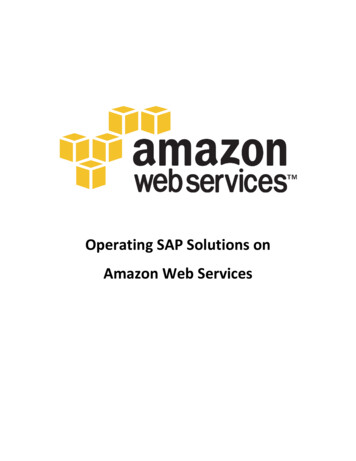
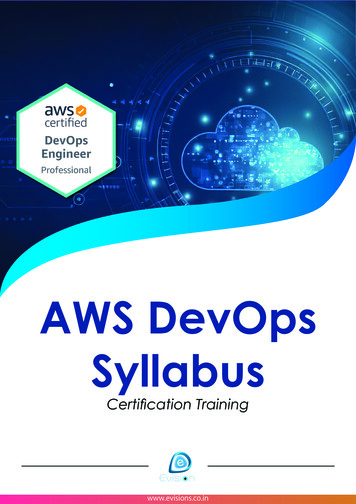
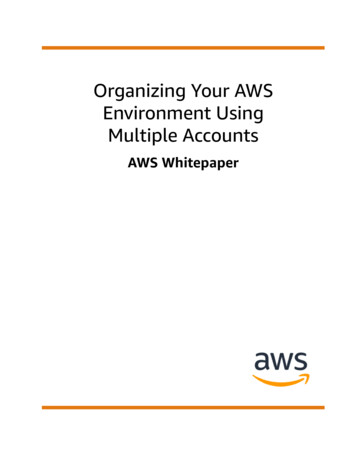
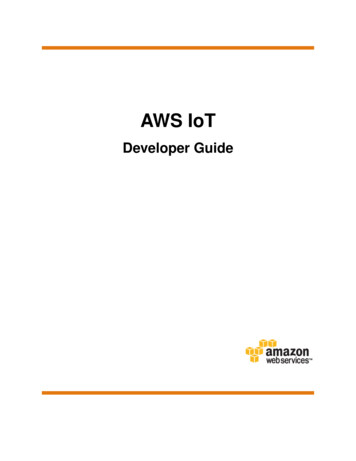
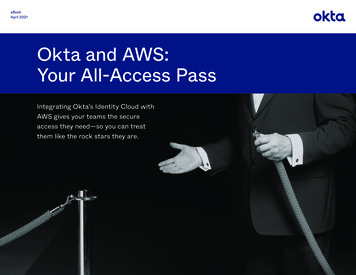


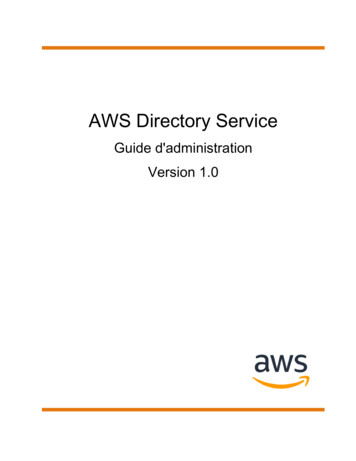
![[AWS Black Belt Online Seminar] AWS X-Ray](/img/17/20200526-blackbelt-x-ray.jpg)